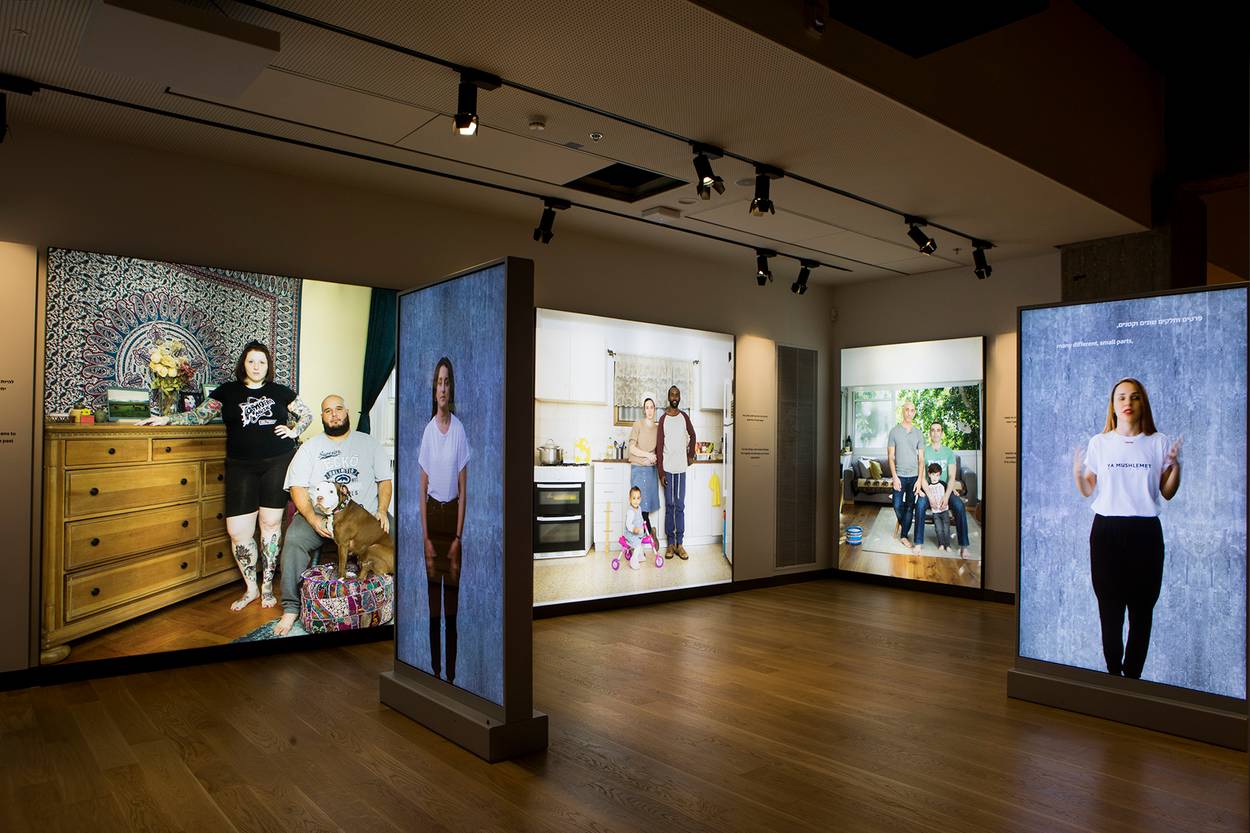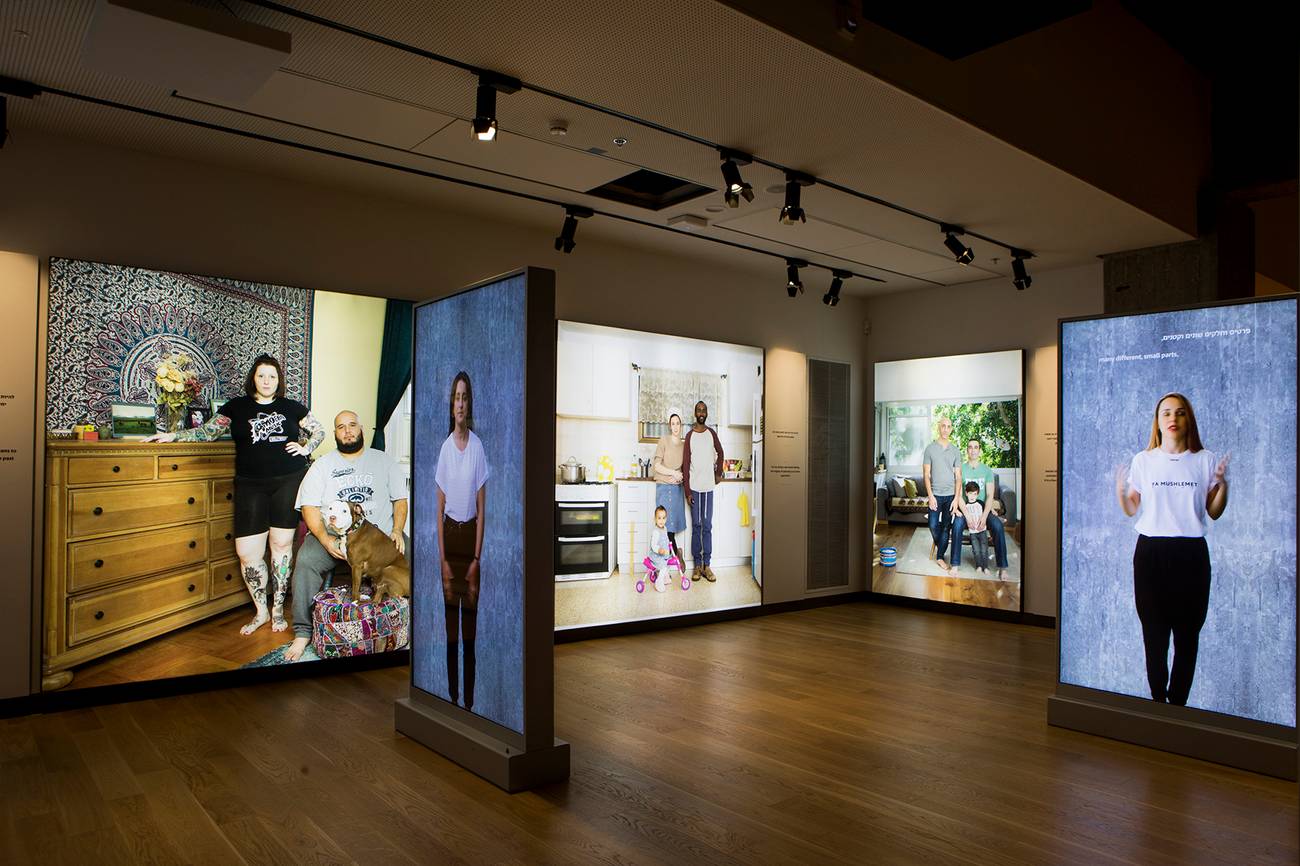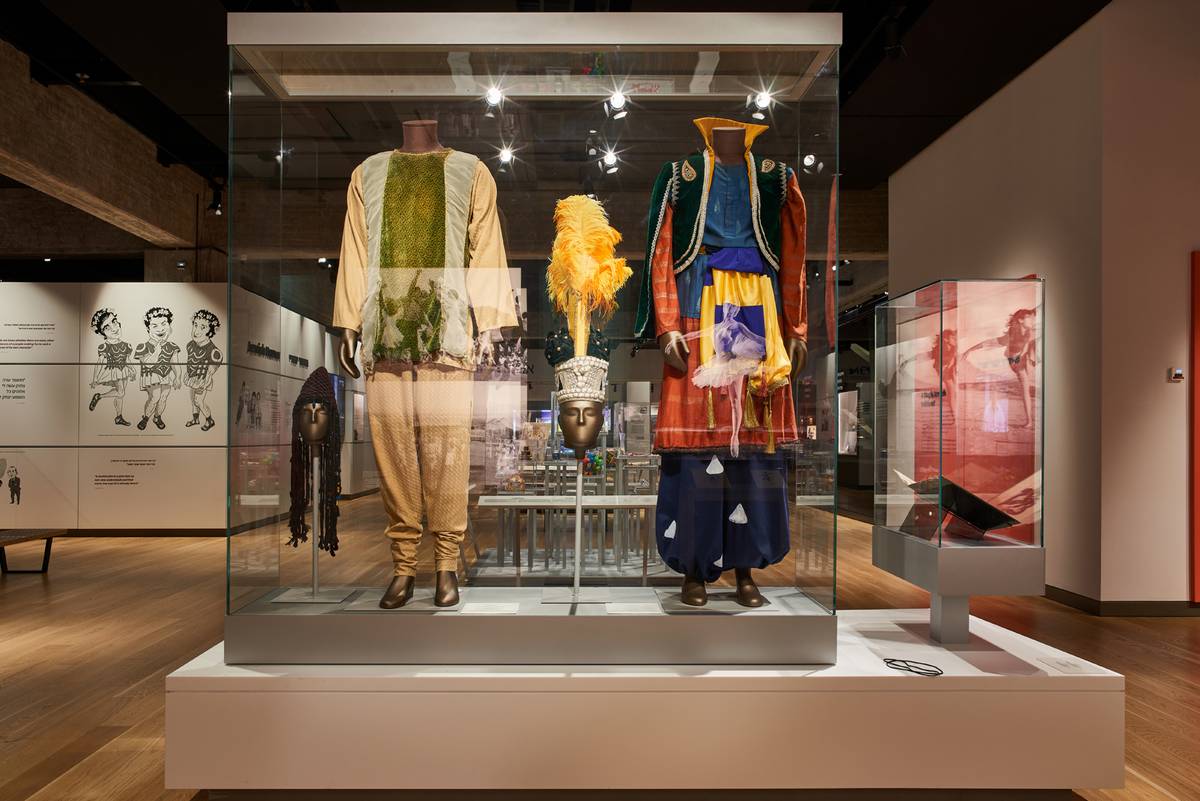ANU, a New Museum of the Jewish People, Opens in Tel Aviv
At a time when the Jewish world feels more divided than ever, the museum offers a vision of radical togetherness




Running a touch-screen cooking experiment at the recently opened ANU—Museum of the Jewish People, I was “beating” eggs and “cutting” carrots for a Moroccan quiche. Arrows, spirals, and zigzags popped up on the screen, prompting the adding, mixing, and cutting hand motions. On another screen, water boiled and butter melted. The only thing missing was the smell of food cooking. The Moroccan quiche mastered, I returned the display to its default position: a full international spread ranging from Tripoli couscous to the Russian pelmeni, to Polish, Turkish, Iraqi, Ethiopian, and Persian dishes, and the Yemenite Jews’ Shabbat delicacy, jachnun.
ANU’s virtual kitchen is one among scores of interactive stations, multimedia displays, artworks, and artifacts whose task is to help the museum explore Jewish identity in all its multifaceted glory and celebrate the contribution of Jews to humanity. The new museum is located on the Tel Aviv University campus in the building that once housed Beit HaTfutsot—the Museum of Jewish Diaspora, which closed a decade ago for what was billed as a renovation. The renovation has proven to be a major conceptual, artistic, technological, and architectural overhaul.
“Anu” means “we” in Hebrew. At a moment when the Jewish world seems more divided than ever, ANU proposes a vision of “us” that is fresh, bold, inclusive—and much needed. Divisive, angry tweets are no match for 72,000 square feet of galleries testifying to our shared Jewish cultural, historical, and spiritual heritage. Seen through ANU’s lens, even the Israel-diaspora division, which features so prominently in American discourse, begins to lose significance. What comes into focus instead is anu—a unique, complex, and vibrant people whose members have made indelible contributions to humanity.
The journey begins on the third floor, which is named “The Mosaic—Modern Jewish Identity and Culture.” Digitally greeting visitors here are 21 individuals from all walks of Jewish life who take 60 seconds to tell their stories. Here’s Ruchie Freier, the trailblazing first Hasidic female judge from New York, who credits her Hasidism for her professional success. On a nearby screen, a secular kibbutznik from the Negev explains that he grounds his Jewish identity in living and creating in Israel. A teacher from Brazil taps into every immigrant’s identity story by asking herself whether she is a Brazilian Jew or a Brazilian Israeli. A lesbian Reform rabbi from Tel Aviv, who describes how queer theory has informed her Judaism, stands next to a be-shtreimeled Hasid expounding on the meaning of joy.
The museum’s radical inclusivity can feel expansive to some and challenging to others—and probably a bit of both to most. Irina Nevzlin, the visionary and driving force behind the new museum, who serves as its chair, acknowledges this. When a Haredi rabbi told her recently that he felt uncomfortable next to an exhibit featuring Rabbi Angela Buchdahl from New York’s Central Synagogue, she advised him to wait until the next picture: “There will be a thousand Haredi men in it, and I will not be represented there, and then I will feel uncomfortable.” The point of the museum, she says, is to help all members of the extended Jewish family to get to know one another.
Representation was the curatorial team’s first priority. “Walking into the museum, people want to make sure they are represented,” ANU’s CEO Dan Tadmor told me. Only once the visitors confirm that they—their specific tribe and their particular identity—are part of the museum’s story will they be willing to take the conversation to the next level: to the discussion of shared history, values, culture, and sense of togetherness. Whether from the perspective of gender, race, ethnicity, denomination, or geography, ANU’s team made sure that everyone is present in its galleries.
Most of the third-floor exhibit space is devoted to exploring Jewish contributions to contemporary culture: from film, music, theater, dance, and comedy to the advancement of women. ANU uses state-of-the-art museum technology to help engage and draw the visitors in. But its most powerful tools are also the oldest and most human—conversation and storytelling. In specially commissioned films, contemporary artists “converse” with their predecessors who informed their art. In one, the award-winning Israeli actress Efrat Ben Zur “discusses” with the legendary Russian-born Israeli actress Hanna Rovina their shared role of Leah in The Dybbuk. The filmmaker Michel Franco, born in Mexico City to a family of Aleppian descent, “talks” with his idol Stanley Kubrick by discussing how the latter influenced his art.
Interspersed among the multimedia exhibits are rare artifacts that tell stories of their own: the Soviet actor Solomon Mikhoels’ King Lear cloak, the white-and-gold outfit Ofra Haza wore in the single Galbi, Leonard Cohen’s guitar, and Ruth Bader Ginzburg’s judicial collar. A 1982 model of E.T. sits in the hall dedicated to Jewish contributions to Hollywood. The stunning seamless gown by the Moroccan-Israeli couturier Alber Elbaz, who created for Lanvin and Yves Saint Laurent and died of COVID-19 just this April, sent me into a world of glamour as I googled his extraordinary life story.
Thoughtful placements lend new dimensions to objects. The Léon Bakst Ballets Russes costume from Scheherazade appears in a new light when placed next to a costume from Israel’s Inbal Dance Theater, whose founder Sara Levi-Tanai and her dancers used their art to explore their Yemeni roots. One’s favorite Jewish jokes acquire fresh notes in a video sequence with Jewish comedians from all over the globe.

Jewish identity and peoplehood have animated Nevzlin since her years of growing up in Moscow. Like many Soviet Jewish children, she first learned that she was Jewish through antisemitic taunts in the street. In 1991, at the age of 13, she traveled to Israel with her grandmother. There she discovered a feeling of connection that was entirely new to her. She wept for hours after visiting the Kotel, despite knowing nothing about its history or significance for the Jews. “It was like meeting someone I never knew before and sensing an instant true and deep bond,” she wrote later in her book The Impact of Identity: The Power of Knowing Who You Are. Shortly after returning home, she told her parents that she was transferring to a Jewish school.
That 13-year-old’s decision “is why I am here at 42,” she told me, explaining how identity and Jewish peoplehood became her life’s mission. Her Jewish school was an environment where she felt loved, supported, and challenged to grow. It also gave her a sense of belonging. “I came out of that school very proud and happy that I’m Jewish, very happy that I’m part of a global Jewish family, and knowing that I will never feel alone—because wherever I go, there would always be someone I’d feel an instant connection with because we have a common story,” she said. “That is exactly the feeling I want people to have at the museum.”
The third floor’s celebratory exploration of contemporary Jewish identity and culture continues on the floor below in the historical wing, which is titled “The Journey: The Jewish Story Through Time.” Several curatorial decisions by the ANU team struck me as notable. One was to weave together the telling of the history of Sephardic and Ashkenazic Jews. “There is a misconception that Jewish communities throughout 2,000 years of diaspora were separate islands,” said Tadmor. “That is simply not true. Throughout Jewish history, Jews traveled, knowledge traveled, scholars traveled.”
Another was to move away from what the historian Salo Baron called the “lachrymose conception” of Jewish history. “As a conceptual decision, we wanted to tell Jewish history not only from victimhood,” said Tadmor. To be sure, persecution and survival are part of ANU’s story, but it doesn’t stop there. “Jews throughout history have thrived and succeeded and flourished, have influenced and have been influenced, and have had cultural dialogue with other cultures,” he noted. “We wanted to tell this story in its entirety.”
This conceptual approach is one reason ANU’s representation of the Holocaust is largely symbolic. Antisemitism is present because it affected Jewish lives, but is almost entirely omitted as a stand-alone concept. “You could have the whole museum be about antisemitism,” Nevzlin told me. “But will it help people get stronger in who they are?” Her objective is different. She hopes to encourage people to embark on a Jewish identity-building journey: That way “when they meet antisemitism, they will know who they are so well that they will know how to address it.”
Among exhibits that stood out for me on the second floor was a section that featured Israeli musicians performing piyyutim—medieval Sephardic liturgical poems that are now part of mainstream Israeli music. I was also moved by a film, in which four young Israeli female singers tell the stories of four Jewish stars of the Arab world of yesteryear—Zohara Al Fassiy of Morocco, Egypt’s Leila Mourad, Line Monty from Algiers, and Salima Mourad from Iraq—and perform their songs.
The first floor, titled “Foundations—a Common Core, a Universal Message,” explores the theological and ethical concepts that have formed the backbone of Jewish identity for thousands of years: Shabbat, the Torah, the Covenant, and the Jewish calendar. The 6,000-square-foot Synagogues Hall contains models of famous historical synagogues from around the world. A set of films invites visitors into different communities’ Shabbat worship. And a musical station illustrates the textual and musical nusach of various Jewish communities.
When the museum opened in March, the pandemic was winding down in Israel but continued to rage in much of the rest of the world. There were no foreign tourists. Even school and IDF tour groups, which beef up attendance at Israeli museums, were not yet coming through. Still, the museum drew 70,000 visitors in its first four months. Tadmor is pleased with this level of interest among Israelis. “There is probably mutual ignorance among Jews all over the world regarding each other, but it may be even more widespread here in Israel,” he said. In his view, this lack of knowledge contributes to a lot of misunderstanding, broken dialogue—and lack of dialogue.
ANU hopes to remedy this failure. In addition to the exhibits, locals come in for events and concerts. The airy Aroma café buzzes with that special Tel Aviv atmosphere that makes life feel like one continuous coffee experience with friends. There is something for everyone here.
Taking another spin at ANU’s virtual kitchen—this time “to make” the Iraqi kubbeh soup—I attracted the attention of two Israeli women. For a few minutes they watched me move my hands over the screen, then started commenting on how “my” recipe and technique differed from those they had inherited from their Iraqi mothers. In a moment’s time we were deep in conversation, the way any three Jewish women might be in a real kitchen anywhere around the world, at any time in history. With a bit more chutzpah, I might have scored myself an invitation to a real homemade meal.
Izabella Tabarovsky is a Tablet contributor. Follow her on Twitter @IzaTabaro.